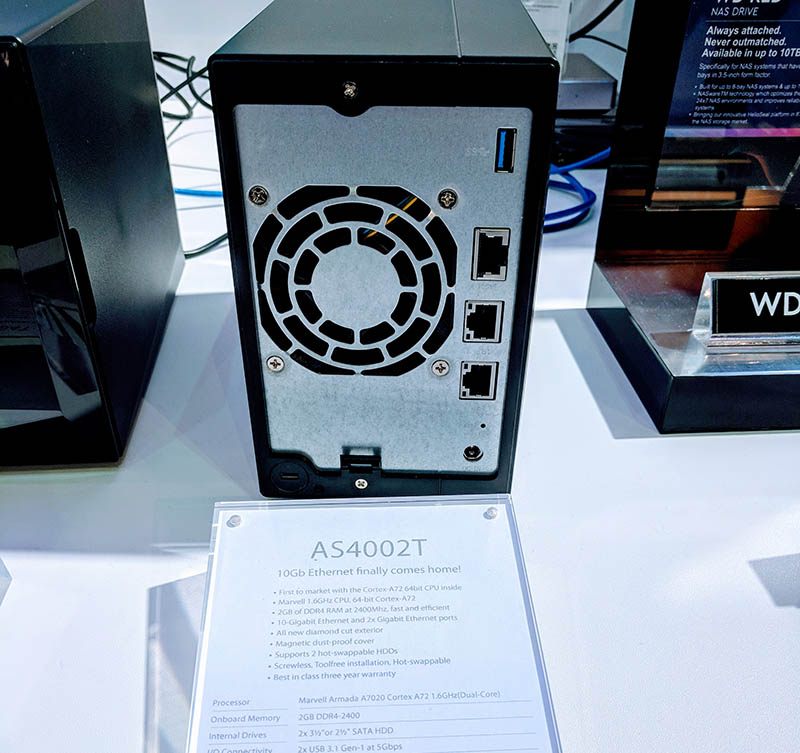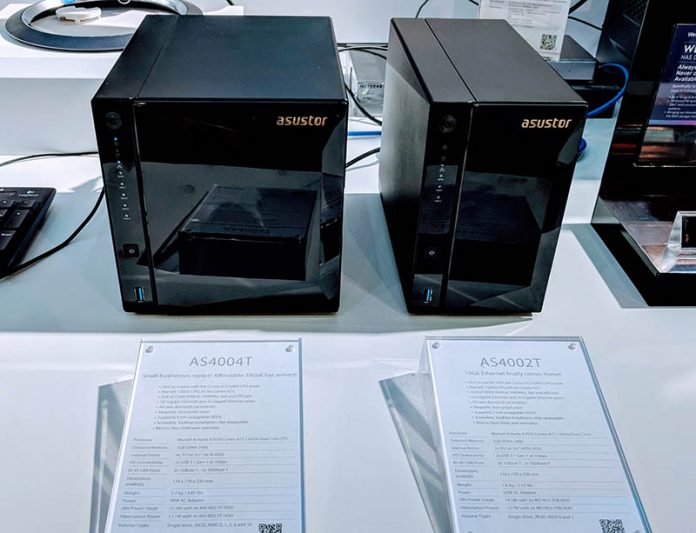Although we often focus on higher-end NAS units at STH, the lower-end is seeing some dramatic shifts. At Computex 2018 we saw two NAS units from Asustor that used lower cost ARM processors but also included 10Gbase-T networking. The Asustor AS4002T and AS4004T are lower-cost NAS units intended as inexpensive network storage for small offices, retail shops, and homes. The NAS units have 10Gbase-T built-in as a major upgrade over previous generations.
Asustor AS4002T and AS4004T ARM-based 10GbE NAS
The Asustor AS4002T is the 2-bay NAS model. The second “4” means that the Asustor AS4004T is a 4-bay model. Both utilize Asustor’s tool-less design which makes them easy to service in the field. They also feature dual 1GbE and single 10GbE (10Gbase-T.) The company had a RAID 5 hard drive array on the Asustor AS4004T running at over 600MB/s.

The NAS units use the dual 1.6GHz core Marvell ARMADA-7020 SoC with 2GB of RAM. This is not the highest-end CPU, but it is enough for this class of NAS. Power consumption is rated at sub 7W for the 2-bay NAS and under 20W in operation largely due to the ARM SoC. These units utilize the company’s GUI based management portal which is designed for novice users. We looked at a previous version of the Asustor GUI and a 2-bay NAS in our Asustor AS1002T 2-Bay NAS Review.
A bigger implication is that, although lower-cost, the Asustor AS4002T and AS4004T are leadership NAS units. Many of Asustor’s competitors are still launching 1GbE only NAS systems in these price bands. At STH, we firmly believe that 2017 was the tipping point for 10GbE and we want to see more NAS units adopt 10GbE and multi-gigabit networking. These days, there are low-cost (sub $250) 10GbE enabled switches and there has been an explosion of devices. As a result, NAS units even in smaller office and home environments are being pushed harder by multiple clients where 10GbE networking can help.





10GbE is still too expensive for SOHO and there is no need for it, too.
2.5/5 GbE could be better/cheaper.
I find it unbelievable that Synology keeps launching new NAS devices that have 10GbE on the SoC but only equip them with 1GbE ports and charge you through the nose for a 10GbE add-on card. It’s great to see that Asustor does have their products aligned with our interests, and they’re definitely a candidate for my next NAS.
ODB – for the low-end there are now 1/10Gbase-T switches on the market that are sub $250 which is very reasonable. Going SFP+ and you can get 1GbE switches with 1-2 10GbE ports for well under $200 and connect to the NAS inexpensively. SFP+ PHYs are very low power and very low cost so using SoC 10GbE is inexpensive.
David – See the Synology RS1219+ piece that just when live where that topic is addressed.
Patrick – Totally agree with the comment on that article. The Asustor will probably cost less than a quarter of that new Synology model so it’s ridiculous that Synology then charges an additional $200 for 10GbE.
In my current deployments it’s starting to be more expensive to use 4GbE ports than SPF+ or even 10GBASE-T, not to mention that there are multiple workloads that cannot utilize bonding as they’re single stream traffic (VEEAM backups for example). At ~40$/port for 10GBASE-T vs ~5$/port for 1GBASE-T the gap is closing quickly.